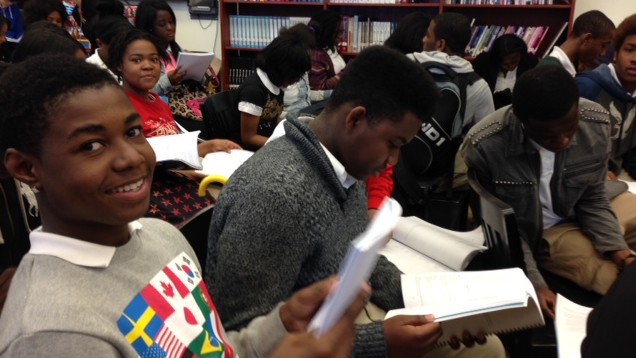In my middle-school writing classroom, songs usher in the students. I had always wanted to mimic my art teacher colleagues and their classroom-entering routine: kids walk in, find the piece they’ve been working on (clay pot, oil painting, charcoal drawing), and begin working. No waiting for everyone to arrive, no wasted time—a seamless movement into class. So for the first five to ten minutes, I play music—a siren call, if you will—and my students get right to work on a piece of writing. I call this daily ritual “Just Write,” and for many of many students, it is their favorite part of English class. Students can write about anything they choose, but I’ve found that prompts work better than the idea of absolute freedom-too much space with no restrictions can be daunting. Sometimes I use images as prompts; I’ve collected a number of paintings, photographs, and drawings that inspire student writing. Either I project an image or I write at least three different prompts on the board.
For example:
- Start with “The truth about me is…” and see where it leads.
- Describe a treasured object in your room. Use the words sliver, tender, and meander in your writing.
- Start a piece with “I don’t know…,” allowing your pen or fingers on the keyboard to lead you.
- Describe something you once believed in. Then describe something you believe in now.
- Think about a kind thing someone has said to you. Weave this dialogue into a description of a morning routine.
- Start with a line from a song you love. Remember a specific place where you first heard it. Jot down everything you can remember about that moment: time, place, the voice and/or instruments in the song, how it made you feel, etc.
- Remember a story you used to love hearing or reading. Who read it to you? Where were you? What were you wearing? What were you feeling? What did the book look like? Do you remember any particular lines?
- Start with “The bases are loaded…”
- Remember an experience in or by a body of water. Where were you? How did you feel?
- Describe a favorite pair of shoes.
- Write a thank-you note to someone who has given you good advice. (Maybe consider sending it?)
- Start with “I am good at…” See where it takes you, and don’t hold back.
- Describe your favorite fruit, and try to remember a specific time eating it. Where were you? Who were you with?
- Remember the first time you did something: riding a bike, sleeping over at a friend’s, swimming, holding a puppy, or writing the alphabet.
- Start with “I know the difference between…”
The music is playing, the students are writing, and I walk around to each student, quietly saying hi, asking how each is doing, checking in, making sure they know I know they are here. I love “hearing” kids write. In the early years it was a soft sound of pen or pencil on a lined page, a smooth papery sound. Now it is often a slight tapping. I know when it’s time to change things up because the writing sounds falter or shift; it’s a bit like knowing when to stop the microwave for popcorn. One pop and some space before the next one—open the door before the popcorn is charred.
So we take a breather, and I read a poem. (Two good sources for poems are Poetry 180, edited by Billy Collins; and Teaching with Fire, edited by Sam M. Intrator and Megan Scribner.) This is what I call the daily “wash-over” of lovely language. I don’t want kids to just hear the language though; I want them to steal some of it. On their computers or in their notebooks, all students have a file or page titled “Cool Words”—this is a list of lifted language from poems. The rule of thumb is that one can use up to five words from any piece of writing without it constituting plagiarism. This word or phrase cannot be essentially another’s, as “…to go before I sleep…” belongs to Frost. The words or phrases students use will be woven into their work in a completely different way than the poet used these words. (If the student or I feel it would be more appropriate to cite or attribute the found language, we discuss the best method for doing so.)
Once students hear the poem and have their cool words in front of them, we go back to music and writing, and they try to infuse the cool words into what they have been writing. The “infusion” process can have magical results. It often adds a surprising element, and as Robert Frost said, “No surprise for the writer, no surprise for the reader.”
Every day we write. There are specific days that I have kids share and respond to each other’s work, and every other Monday a two- to three-page expansion of a “Just Write” is due. Once kids settle on a piece they want to continue working on during the week, the “Just Write” time becomes an opportunity to expand the piece, using the new prompts and new cool words as a means to propel their writing into unforeseen places.
I believe in free writing. I have seen my students’ writing become more fluid and strong as a result of this meditative, low-stakes, in-class practice. The “Just Write” sessions help students to become stronger, more confident writers, while simultaneously enabling them to explore their creativity, to discover who they are and what they think, and to make sense of their universe. As Flannery O’Connor said so succinctly, “I write to discover what I know.”
The italicized word in the following student writing samples are taken from poems that we read aloud—their cool words.
*
Untitled
By AlexandraThe ominous clouds whispered secrets of the future to the fishing town. There was not a single ripple in the murky, green water; the boats were mostly docked, and their burnished lamps lit up the dark like fireflies. Suddenly, bright flashing lights sliced through the sky and spread like the branches of a tree. The calm sky was ripped open. Pebbles of rain ricocheted off the rooftops like marbles. People looked outside at the lightning, babies cried, but the thunder didn’t bother to quiet down. The sky continued its tantrum, its screaming, and its roars of anger. A few minutes later, it stopped and backed away into the clouds. Everything was silent except for the babies and their mothers hushing them.
*
Weather of Being
By JocelynIn the Yukon I stand
on a vast ancient prairie
covered by snow in the middle
of the night, wearing the thickestdown coat I can imagine.
Looking at the sky, I hope
I will be lucky enough
to see Aurora Borealis.Suddenly, several stripes of green
“clouds” appear in the darkness.
The green clusters of light
in the air move so fastthat I feel nothing is real.
They last only for a few minutes,
then vanish. The clear
wind and I witness this.
*
Untitled
By JonahOh disappearing photograph, the dark clouds soar above my family as I grasp onto my mother’s soft, dry, white fur coat staring into sand dune. My mom’s face is filled with elation and desperation for the wedding to begin. My sister stares into the camera, her head filled with joy and a soft pink rose sticking out of the top of her headband almost touching my step-father’s long purple tie.
Sarah Dickenson Snyder has taught English for over 35 years. Recently, she retired to pursue her love of writing both poetry and prose. She was selected to be part of the Bread Loaf Writers’ Conference and has had poems published in The Comstock Review, Bloodroot Literary Magazine, West Trade Review, The Main Street Rag, Zeugma Magazine, Mothers Always Write, and other journals, reviews, and book anthologies. In May of 2016, Snyder was a 30/30 Poet for Tupelo Press.



